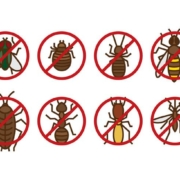Dealing with pests is an unfortunate but common challenge for many homeowners. Beyond being a mere nuisance, pests can cause a range of serious issues in your home, from structural damage to health problems. Understanding the risks associated with what pests can do to your home can help you recognize the importance of regular inspections and timely and effective pest control.
Recently we wrote a blog explaining the value of periodically inspecting your home for pests. Today we’re going to delve into the details about what pests can do to your home and how they can endanger your health and property.
Structural Damage
Termites – When it comes to structural damage termites are perhaps the most notorious pests. These insects feed on wood, which can compromise the strength and safety of your home’s framework. According to the National Pest Management Association, termites cause over $5 billion in property damage annually in the United States alone. As homeowners’ insurance does not typically cover this damage, prevention and early detection are crucial.
Carpenter Ants – Similar to termites, carpenter ants damage wood. However, unlike termites, they do not consume the wood but rather excavate it to create nests. This can weaken the wooden structures in your home over time, leading to costly repairs.
Rodents – Mice and rats can also pose a threat to your home’s structure. They have strong teeth that can gnaw through wood, electrical wiring, and even plumbing. This not only causes structural damage but can also lead to electrical fires and water leaks.
Health Risks
Allergies and Asthma – Certain pests, such as cockroaches and dust mites, are known to trigger allergies and asthma. The allergens come from their droppings, shedding of body parts, and the dust they accumulate. These particles can become airborne and exacerbate or lead to respiratory issues.
Disease Transmission – Pests like rodents, mosquitoes, and ticks can carry diseases. Rodents are notorious for spreading Hantavirus, leptospirosis, and even the bubonic plague. Mosquitoes are vectors for diseases such as Zika virus, West Nile virus, and malaria. Ticks can transmit Lyme disease and other serious infections. Managing these pests is vital to maintaining a healthy living environment.
Food Contamination
Pests such as ants, rodents, and cockroaches can contaminate food by spreading harmful pathogens. Diseases like salmonella and E. coli can be transmitted through contaminated food or surfaces. Ensuring that food areas are clean and well-sealed against pests can help minimize this risk.
Financial Implications
The financial impact of what pests can do to your home can be substantial. The Nation Pest Management Association (NPMA) estimates Americans spend $5 Billion annually treating and repairing termite damage. Additionally, regular pest control services, while necessary, also represent an ongoing expense. In severe cases, the value of a property can diminish due to infestations, particularly if they are not managed promptly.
Conclusion
The potential harm related to what pests can do to your home is extensive and varies from physical damage to health risks. Regular inspections and maintenance are key strategies in preventing pest infestations.
If pests are already present, professional extermination services are often the most effective way to handle the problem. Remember, the sooner you address the issue, the better you can protect your home and health from the significant threats posed by these unwelcome intruders.
As the top pest inspection company in Rhode Island, Massachusetts, and Connecticut CMS Home Inspection offers effective solutions. During a pest inspection, we inspect the interior and exterior of your home, and report on evidence of unwelcomed guests. We also look to identify defects caused by pests, such as wood damage resulting from termites. From squirrels in the attic to ants in the kitchen, and everything in between, CMS Home Inspection has seen it all during pest inspections. Let’s connect if you have any questions or want to schedule a pest inspection.


